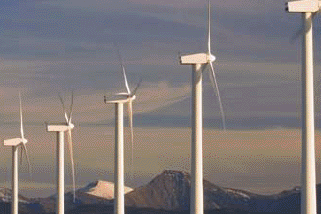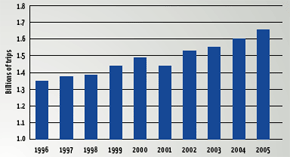Building Canada - Modern Infrastructure for a Strong Canada - Building Canada: the Plan - Building a Cleaner Environment
Building Canada: the Plan
Building a Cleaner Environment
In Montreal, transit contributes almost $1 billion in added value to the economy each year and enables Montreal households to save $570 million annually.
Board of Trade of Metropolitan Montreal, Public Transit: A powerful economic development engine for the metropolitan Montreal region, December 2004
Building Canada will focus on infrastructure investments that contribute to cleaner air, water and land.
Wastewater
The quality of wastewater effluent can have a direct impact on human health. Yet, in too many cities and communities across Canada, treatment of wastewater is either insufficient or non-existent. Fifteen percent of inland communities undertake only primary level wastewater treatment.16 Advanced treatment facilities provide additional layers of protection with secondary and tertiary treatment.
Although some communities have advanced wastewater treatment plants, many others are dumping untreated or poorly treated liquid waste into natural water systems. Coastal communities face the greatest challenges, with the majority having only primary treatment, and some, no treatment at all. And even when there is adequate wastewater treatment, stormwater can cause the sewer system to overflow, allowing raw sewage to spill directly into our rivers, lakes, and oceans. This is a situation that all levels of government must work hard to correct.
Building Canada will encourage investments in wastewater infrastructure designed to:
- Reduce the negative impacts of municipal wastewater effluent or storm-water effluent on human health and the environment;
- Improve the management of wastewater sludge;
- Improve the management and efficiency of municipal wastewater infrastructure or storm-water infrastructure;
- Improve the quality of treated municipal wastewater effluent and storm-water discharged into the environment.
"Federal investment in transit would support the growth and development of more compact cities and support more transit connections between cities and growth areas."
Federation of Canadian Municipalities, Towards a National Transit Strategy – Issue Briefings, 2006
Public Transit
Public transit is a key part of urban transportation infrastructure. Sound investments in public transit can improve mobility and help get people out of their cars, which reduces traffic congestion, greenhouse gas (GHG) emissions and air pollution. In addition to the environmental value, these investments benefit the economy and quality of life in cities. Well-planned public transit systems that are integrated into the urban form can provide a fast, effective and economical transportation option for city residents, as well as broader access to jobs, education, health care facilities and recreational facilities. And for many users, public transit is often the only affordable option.
"Between 1990 and 2004, road vehicles contributed to 86 percent of the growth in emissions from transportation. In 2004, transportation also consumed nearly one third of all energy used in Canada. If the trend continues over the next 25 years, a 40 percent growth in fossil fuel consumption will be needed to support current patterns of transportation."
National Round Table on the Environment and the Economy, State of the Debate: The Road to Sustainable Transportation in Canada, 2007
As reported by the Canadian Urban Transit Association (CUTA), transit ridership in Canadian cities reached an all time high in 2006, and has grown by 16 percent over the past five years.17 However, the modal share accounted for by transit has not increased at the same rate. Building Canada aims to support the increased use of transit, as well as increased transit modal share, and help Canada's cities and communities meet future public transit demand. Funding of these projects will complement other federal initiatives such as the transit pass tax deduction and the Public Transit Fund.
Building Canada will promote public transit infrastructure investments designed to:
- Improve mobility, reduce travel times and increase safety and efficiency;
- Expand public access and ridership;
- Reduce the growth of GHG and other emissions;
- Contribute to sustainable municipal development and land-use planning.
Green Energy

Wind turbines in Southern Alberta
Canada relies heavily on fossil fuels for heat and electricity. Air quality is particularly affected by conventional fossil fuel burning technologies used in electricity generation and transportation. Coal fired generating stations, for example, are a significant source of air pollution and GHG emissions. Canada needs new, cleaner and more efficient energy infrastructure to meet its expanding demand.
Building Canada will stimulate investments in sustainable energy infrastructure that contributes to:
- Increased availability and/or security of Canada's clean energy supply;
- Increased availability of renewable energy;
- Improved air quality;
- Reduced GHG emissions.
Solid Waste Management
As the population grows and Canadians' standard of living improves, dealing with solid waste becomes a growing challenge. As Canadians consume more, they produce more solid waste for disposal. The amount of garbage Canadians produce, particularly in large cities, can generate conflict and disagreement over disposal locations, and solid waste in landfills, regardless of location, poses numerous environmental threats. Poorly managed landfills can contain high levels of toxic chemicals that may leak into surrounding environments. Landfills are also a source of methane gas - a greenhouse gas - and other types of air pollutants.
Nanaimo - From sewage to electricity
With the help of the federal Gas Tax Fund, the Regional District of Nanaimo in British Columbia is upgrading its sewage treatment plants and adding a co-generation facility to convert biogas from sludge into electricity. By turning sewage waste into electrical energy, the region will generate energy equivalent to the amount used by 250 homes.
The Province, "Nanaimo to create electricity with sewage," July 17, 2007, page A18
Effective infrastructure solutions can help reduce the quantity of waste going to landfills as well as its potential harm to the environment. This includes innovative processes that can transform waste into useful products, including energy.
Building Canada will promote investments in solid-waste processing infrastructure that can reduce the environmental impacts resulting from municipal solid waste management.
[16] Environment Canada, Environmental Signals: National Indicator Series 2003
[17] Canadian Urban Transit Association, Canadian Transit Ridership Breaks All-Time Record Again in 2006
- Date modified:
